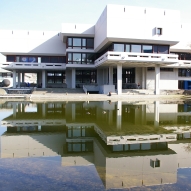Zusammenfassung
Dielec. spectra have been measured for aq. sodium oxalate solns. up to the satn. concn. (0.04 ≤ c [mmol L-1] ≤ 0.25) at 25 °C over the approx. frequency range 0.2 ≤ v [GHz] ≤ 20. The spectra exhibit a process at about 1 GHz assocd. with the presence of ion pairs, in addn. to the dominant solvent relaxation process at about 18 GHz. Detailed anal. of the solvent dispersion amplitude indicates ...
Zusammenfassung
Dielec. spectra have been measured for aq. sodium oxalate solns. up to the satn. concn. (0.04 ≤ c [mmol L-1] ≤ 0.25) at 25 °C over the approx. frequency range 0.2 ≤ v [GHz] ≤ 20. The spectra exhibit a process at about 1 GHz assocd. with the presence of ion pairs, in addn. to the dominant solvent relaxation process at about 18 GHz. Detailed anal. of the solvent dispersion amplitude indicates that the oxalate ion is highly hydrated but that its solvation sheath is "fragile", decreasing quickly with increasing solute concn. The NaOx(aq)- ion pair is shown to be of the double-solvent-sepd. (2SIP) type, with an infinite diln. assocn. const. KA = 1.04 ± 0.02. Anal. of the ion-pair relaxation time as a function of solute concn. gave rate consts. for the formation (k12 = (7.3 ± 0.4)109 L mol-1 s-1) and dissocn. (k21 = (6.7 ± 0.5)108 s-1) of the ion pair. These values are reasonably close to the diffusion-controlled values predicted by the Eigen theory, consistent with a 2SIP structure for the ion pair.




 Altmetric
Altmetric